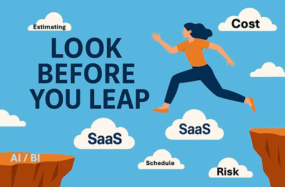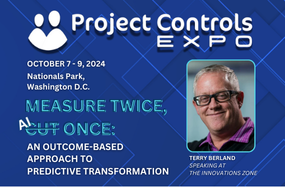
Breaking Down Data Silos: How Seamless Integration Enhances AI-Driven Project Management

In the world of capital-intensive project management and controls, the difference between delivering on time and falling behind often comes down to one factor: data. Not just access to data—but unified, trustworthy, real-time data. Yet for most project-intensive organizations, achieving this level of clarity is elusive. Why? Because their data is trapped in silos.
As project teams juggle dozens of disconnected applications—Primavera P6, Asta, Unifier, ERP platforms, custom tools, and a patchwork of spreadsheets—gaps emerge. These silos breed rework, delay decision-making, and limit the effectiveness of even the most advanced reporting and forecasting tools.
And in an era where artificial intelligence (AI) and machine learning (ML) are reshaping how organizations plan, analyze, and deliver complex projects, data silos aren’t just inconvenient—they’re a roadblock to innovation.
This is where seamless application integration becomes mission-critical.
Why Silos Persist in Project Controls
Project teams have always relied on a mix of tools for planning, estimating, scheduling, procurement, and risk management. But the rise of SaaS platforms, cloud-native tools, and continued reliance on legacy systems has multiplied the number of data sources in play. According to a recent Deloitte report, 63% of organizations cite data fragmentation as a key barrier to digital transformation.
For project professionals, this fragmentation creates a familiar and frustrating scenario: opening a dozen browser tabs to piece together status updates. One system has schedule data. Another houses cost codes. A third tracks scope changes. The result is manual consolidation, misaligned reports, and a fundamental disconnect between project performance and business insight.
The Promise of App and Data Integration—and Why It Matters Now
With the growing adoption of AI-driven tools in project controls, the need for seamless integration has never been more urgent. Predictive analytics and intelligent automation depend on access to consistent, high-quality, cross-application data. If your AI doesn’t see the full picture, it can’t provide accurate guidance.
Integration solves this in three ways:
- Centralized Access: Bringing all your apps and data—whether SaaS, on-prem, or proprietary—into a single, secure cloud environment eliminates swivel-chair analysis and version control issues.
- Contextual Insight: Integrated data allows for richer AI interpretation. Project forecasting models can now understand not just the “what” but the “why” behind risks and trends.
- Continuous Learning: Unified systems create the feedback loop needed for AI models to learn and improve, building a cycle of smarter, faster decision-making.
Why Now? AI Can’t Thrive Without Integrated Data
There’s no shortage of hype around AI in project management, and for good reason. AI-powered tools are helping companies identify cost overruns before they happen, model risk with greater accuracy, and generate insights that used to take analysts days to produce.
But AI is only as good as the data you feed it.
If your applications aren’t integrated—if data is incomplete, out-of-sync, or inaccessible—AI becomes a blunt instrument. You might still get charts. You might even get some automation. But you won’t get intelligence.
Seamless integration isn’t just a technical upgrade—it’s a strategic prerequisite to making AI work for your projects.
Executive Benefits: What Leaders Gain from a Unified Ecosystem
For project executives and controls leaders, integration delivers strategic advantages:
- Faster Decisions: With centralized dashboards and NLP-based data querying, decisions that once took a week now take a minute.
- More Accurate Forecasts: AI-powered models deliver early warnings based on live data—not last month’s spreadsheets.
- Greater Agility: As project scope changes or new tools are introduced, LoadSpring’s modular cloud platform adapts without disruption.
- Stronger Governance: Centralized access means better control over who sees what, with audit trails and role-based permissions built in.
Use Case: What Integration Looks Like in Action
Let’s say you’re managing a $500M infrastructure project. The schedule lives in P6. The estimating is tracked in CostOS. Field data comes in via Excel and mobile apps. Reporting is done in Power BI, stitched together weekly by an analyst.
Now imagine that:
- All these applications are hosted in one environment.
- Schedule delays automatically surface against budget forecasts.
- Cost variances can be queried in plain English: “Why did labor costs spike in Q3 for Zone B?”
- Your executive team views real-time risk indicators without waiting for a weekly update.
That’s not the future. That’s what LoadSpring is enabling right now.
Enter LoadSpring: The Unified Ecosystem for Project Intelligence
LoadSpring offers a cloud-based ecosystem built specifically for project-intensive enterprises. Unlike general-purpose cloud platforms or BI dashboards, LoadSpring’s platform is designed to host and integrate all the tools your teams rely on—from Oracle Primavera and Unifier to Elecosoft Asta Powerproject, Deltek, and custom-built applications.
Here’s how LoadSpring enables true project intelligence:
- Centralized Cloud Ecosystem: Securely host and manage all your major project management software in one place, allowing you to centralize your tools and data for better control and accessibility.
- Single Pane of Glass: Gain real-time visibility across your portfolio with executive dashboards and AI-assisted querying that connect directly to your data—no exports or delays.
- Seamless Integration: Integrate with SaaS, on-prem, third-party, and legacy systems, enabling your data to flow freely without compromising security or governance.
- AI-Ready Architecture: With a clean, unified data layer as the foundation, your organization can layer on machine learning, forecasting models, and LLM-based natural language querying tools like LoadSpring INSIGHTS™.
- Implementation and Support Services: Benefit from accelerated implementation, configuration, training, and support to get your project management solutions up and running quickly, so you see value and ROI faster.
The Bottom Line: Integration = Intelligence
If the last decade was about digitizing tools, this decade is about connecting them. The winners in project delivery won’t be the ones with the most apps. They’ll be the ones who can unify those apps into a seamless ecosystem—and use that foundation to unlock predictive insight, real-time visibility, and faster action.
That’s why LoadSpring is more than a hosting provider. It’s your partner in transforming application chaos into coordinated project intelligence.
Ready to connect the dots across your project ecosystem?
Let us show you how LoadSpring delivers real integration—and real results.








